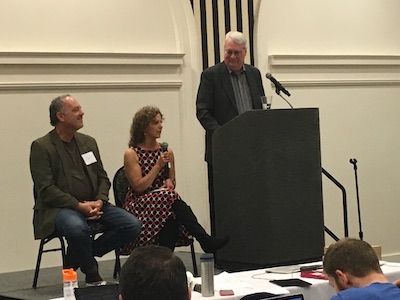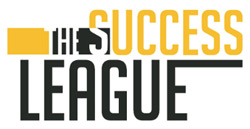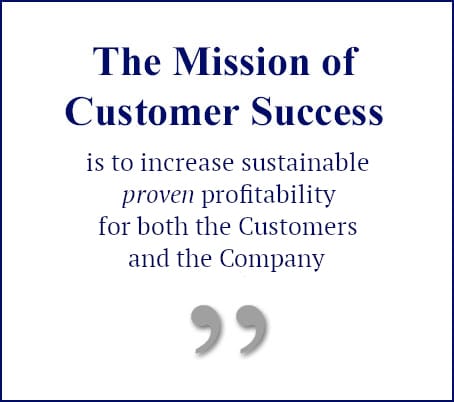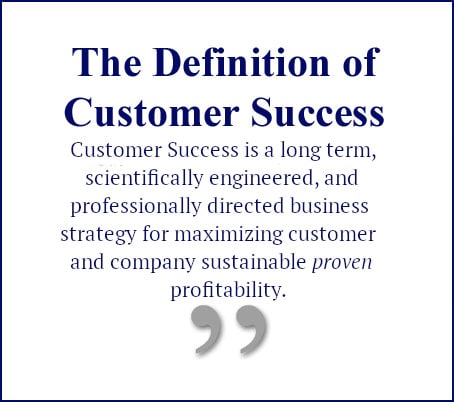You spend your days preventing customers from churn. But how are you protecting you and your team from churn? While Customer Success is a new and exciting industry, not everyone is convinced about its value. As Customer Success professionals we face both ways: we must demonstrate to customers the value of our product, and also to management the value of our CS services. This is our challenge and our opportunity.

From left to right: Mark Pecoraro, Donna Weber, and Mikael Blaisdell at Customer SuccessCon West in Berkeley, CA, November 29, 2018.
Mikael Blaisdell, in the article Customer Success and Value-‘Provability’ shares, “the true goal of Customer Success is getting the decision-makers at both the customers and our company to acknowledge and confirm receipt of the tangible value that we deliver. It’s about money. That’s the proof of value that counts.” I recently had the privilege to join Mikael and Mark Pecoraro of CS Leadership on a panel for the “The At-Risk Customer Success Group” session at Customer SuccessCon West. Mikael shared stories about entire Customer Success (CS) teams being let go. His perspective is that because CS professionals often shy away from metrics, data, and financials, their teams are are sidelined, disregarded, and seen as an unnecessary expense.
Having worked in customer enablement for 20 years, I know this problem well. No one quite understands what we do and the impact we have. We are often seen as a cost center and when budgets get tight, guess who’s first to go? I personally experienced this when I led a Customer Education group at a startup. Even though I shared the quarterly metrics of course attendees and survey feedback, I didn’t connect the dots to the business bottom line. As a result, when cost cutting was needed, management didn’t understand the value my team provided. My entire team and I were let go.
Don’t let that happen to you. Make sure you are seen as an investment, not a cost with these three keys to prove your value.
3 Keys to Prove your Value.
1.Track your efforts. Don’t wait to implement a customer success management system. Instead, get started with whatever tool is at hand; a spreadsheet will do. It’s important to define your processes and customer touch points, so track the activities you and your team perform to help customers be successful. Then document what your team spends their time on. You want to understand how long customer facing activities take and how many touch points customers need to reach milestones. This helps you understand what efforts are working and where to invest.
At my previous company we created a custom object in Salesforce to track CS activities. Being a new team, it was important to understand what we were up to. By tracking our efforts, we could validate where our time and energy were spent. This was especially important because we transitioned from a reactive fire-fighting team, to a proactive team. We implemented a new customer journey and needed to show our influence quickly.
2. Measure what matters. Don’t wait for a data analyst. Instead, start measuring your impact. First, understand what truly matters to your executives and the board. Is there one metric that drives the company? It might be annual contract value (ACV), annual recurring revenue (ARR), product usage, or lifetime value (LTV). Next, explore how your efforts impact that master metric. Dig into existing systems to uncover influence. Don’t waste time trying to prove causation or waiting a year to show higher renewals from onboarded customers. Rather, explore leading indicators like product usage, net promoter score (NPS), customer health score, and customer engagement metrics.
A colleague of mine wanted to understand the effect of his customer enablement programs on customers, so spreadsheet in hand, he manually worked his way through Salesforce to compare companies that benefited from his services and those that did not. He uncovered data that showed enabled customers buy eight times more software than customers who don’t.
3. Be a Marketeer. Don’t wait for others to notice. Instead, think like a business owner. This means not just delivering your CS programs, but also marketing and selling your value to both customers and internal teams. When I work with companies we create a go to market plan that defines how to advertise customer facing programs and offerings, even if they are ‘free.’ It’s important to include both external and internal marketing and selling strategies in the go to market plan.
Let internal teams and leadership know where you fit in and what you are up to. Making one big announcement isn’t enough. Instead, I like the “drip-feed” approach with regular outreach to internal teams. I recommend sending monthly internal newsletters to share benefits, trends, use cases, and influence the team has with customers. Join sales calls on a regular basis to keep sales reps current with how you make their lives easier and their deals larger. Work with Marketing teams to create collateral for customer facing teams to leverage.
Others don’t care about Customer Success as much as we do. So, constantly demonstrate your value to internal teams and management. Peter Drucker said, “What gets measured gets managed.” So, start tracking and measuring what you do. Make it a regular part of your week to measure what matters and market your benefits to internal teams. People wonder what you and your team are up to, and it helps when you can show them. Share your findings with others rather than waiting for them to ask. The trends that appear just might help you get more resources.
Donna Weber

Donna Weber is President of Springboard Solutions and Principal of KickStart Alliance. She specializes in the post-sales customer success journey. Donna builds programs that enable, on-board, and educate customers and has a proven track record helping hi-tech firms create customers for life. Her clients range from start ups to well-established large companies, with a focus on the open source and SaaS arena. With over 20 years’ experience, colleagues know Donna as a leader who makes a difference.









